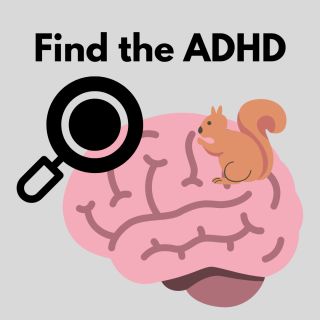ADHD
Can We Develop a Brain Test for ADHD?
Two decades of research examine how brain electricity relates to attention.
Posted August 7, 2023 Reviewed by Devon Frye
Key points
- Researchers have examined how electrical activity of the brain relates to attention.
- The ratio of slow waves to fast waves at the front of the brain, called the Theta Beta Ratio (TBR), is key.
- TBR has been related to trait levels of attentional control and drive to pursue goals, and to mind wandering.
- TBR cannot distinguish between people with and without ADHD, but it may help us understand attention better.

Several years ago, I was sitting around with some friends talking about our (occasional) difficulties paying attention. This was a graduate seminar in psychology, so we brought up psychological evaluations for ADHD.
It turns out that both my colleagues hadn’t just noticed that they sometimes have difficulty paying attention to lectures (which I have found is greatly alleviated by note-taking and coffee), they had gone in for formal evaluation by a psychologist. They had been asked questions about their symptoms (like “How often do you make careless mistakes when you have to work on a boring or difficult project?”), but then they had what they referred to as the “real test”: a computerized test of attention where they were asked to sit for an extended period responding to tones and images with rapid button presses. (Now I realize they were likely taking the Test of Variables of Attention, or TOVA.)
The attention test felt more real because it was something that didn’t depend as much on their own judgments and subjective interpretations (what really counts as “boring or difficult”? What’s a “careless mistake”?). Instead, it relied on their performance on a task–no worry about interpreting the questions right.
But what if we could get an even faster, more basic reading of whether you have ADHD? What if you could just put a cap on someone’s head, measure the electrical signals it gives off, and determine if they have ADHD?
For many years, neuroscientists have been looking into just that. One key indicator they’ve researched is the ratio of slow brain waves to fast brain waves at the front of the head. Since the slow waves in question are typically referred to by the Greek letter theta, and the fast waves referred to by the Greek letter beta, the quantity is called the Theta Beta Ratio (TBR). For over 20 years, different types of studies have explored whether the TBR can tell us something about a person’s attention.
One type of study has related self-reports of difficulty with attention to the TBR. There have been some reliable, moderately sized correlations between TBR and people’s ratings of their own ability to control their attention:
- In 2010, Putman and colleagues reported a correlation of TBR with attentional control of r = -.40.
- In 2014, Putman and colleagues, in a different study, reported a correlation of TBR with attentional control of r = -.33.
- In 2016, Angelides and colleagues reported a correlation of TBR with attentional control of r = -.47.
Correlations can run from -1 to +1, and negative correlations in the -.33 to -.47 range are generally considered moderate to large. They indicate that the higher the TBR measured from a person, the more problems they have with attention. However, the relationship is far from perfect. It would be better to consider it a “conversation starter” or potential screener: if TBR is high, it would be worth looking into attention problems more.
TBR has also been related to another interesting self-reported trait: persistent goal pursuit. (For the psychology nerds out there, it is the Drive subscale of the Behavioral Activation Scales.) Higher TBR was positively correlated (r = .43) with more persistent goal pursuit. So now high TBR has been related to both less control over attention, and more persistence in pursuing goals.
Several other studies have looked at how TBR is related to tasks people are being asked to do. Here’s a quick summary of some interesting results:
- If a person had higher TBR, they were less able to control their attention after a stressful math task. (Putman and colleagues, 2014)
- If a person had lower TBR, they were better at orienting–being able to shift attention to what’s more important or relevant–in an attentional control task. (Morillas-Romero and colleagues, 2015)
Other studies looked at how TBR changed while doing tasks. Unlike the studies above, these didn’t just measure TBR while a person was sitting quietly, but actually measured how TBR changed during a task:
- In one study, participants had to respond to a series of images by deciding whether to press a button or not. Their TBR response was related to measures of how complex they found the stimulus to be, suggesting that TBR might indicate how much “cognitive capacity” (thinking resources) was being used. (Clarke and colleagues, 2019)
- In another study, TBR was found to be higher during times when participants said their mind was wandering. (Son and colleagues, 2019)

The previous studies suggested that high TBR might be related to ADHD: it indicated less ability to control attention, and a greater intensity of goal pursuit. We can now add: high TBR is related to being less able to control attention in the face of stress, and worse orienting ability. Finally, we can say that TBR increases when people see something as more complex and when their mind starts to wander. Together, these findings start to paint a picture of TBR as a possible brain indicator of ADHD.
So what happens in studies where we try to predict who has ADHD from TBR? Unfortunately, we don’t get great results. A study in 2019 by Kiiski and colleagues found that TBR could not clearly distinguish people with ADHD from people without it.
So, unfortunately, an easy brain test for ADHD isn’t coming soon. However, there are enough interesting findings here that brain activity might be something to consider alongside established tests of ADHD, like self-report and computerized attention tests.
It’s also worth noting that the U.S. National Institutes of Mental Health (NIMH) has committed to funding research on looking for more basic, brain-based mechanisms for mental health problems through their Research Domain Criteria (RDoC) program. So researchers may eventually develop an understanding of ADHD that better highlight brain activity, like the TBR marker.
For now, however, psych grad students will still have to talk about the “real test” for ADHD as the ones we already know: paying attention.
References
Putman, P., Verkuil, B., Arias-Garcia, E., Pantazi, I., & van Schie, C. (2014). EEG theta/beta ratio as a potential biomarker for attentional control and resilience against deleterious effects of stress on attention. Cognitive, Affective, & Behavioral Neuroscience, 14, 782-791.
Putman, P., van Peer, J., Maimari, I., & van der Werff, S. (2010). EEG theta/beta ratio in relation to fear-modulated response-inhibition, attentional control, and affective traits. Biological psychology, 83(2), 73-78.
Clarke, A. R., Barry, R. J., Karamacoska, D., & Johnstone, S. J. (2019). The EEG theta/beta ratio: a marker of arousal or cognitive processing capacity?. Applied psychophysiology and biofeedback, 44, 123-129.
Angelidis, A., van der Does, W., Schakel, L., & Putman, P. (2016). Frontal EEG theta/beta ratio as an electrophysiological marker for attentional control and its test-retest reliability. Biological psychology, 121, 49-52.
van Son, D., de Rover, M., De Blasio, F. M., van der Does, W., Barry, R. J., & Putman, P. (2019). Electroencephalography theta/beta ratio covaries with mind wandering and functional connectivity in the executive control network. Annals of the New York Academy of Sciences, 1452(1), 52-64.
Kiiski, H., Bennett, M., Rueda‐Delgado, L. M., Farina, F. R., Knight, R., Boyle, R., ... & Whelan, R. (2020). EEG spectral power, but not theta/beta ratio, is a neuromarker for adult ADHD. European Journal of Neuroscience, 51(10), 2095-2109.
Morillas-Romero, A., Tortella-Feliu, M., Bornas, X., & Putman, P. (2015). Spontaneous EEG theta/beta ratio and delta–beta coupling in relation to attentional network functioning and self-reported attentional control. Cognitive, Affective, & Behavioral Neuroscience, 15, 598-606.




